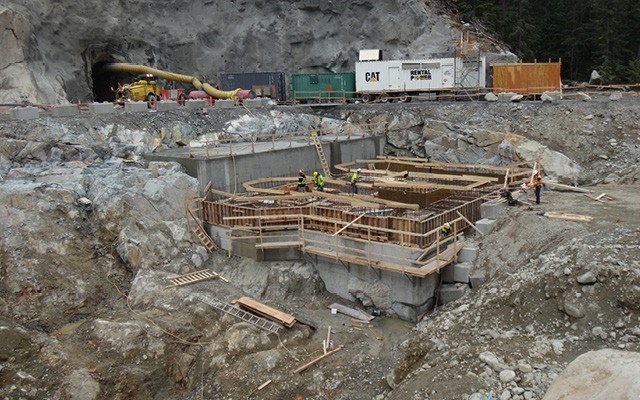Commercial operations have officially begun at a run-of-river hydroelectric facility in Boulder Creek, northwest of Pemberton.
Following construction delays due primarily to a wildfire in the summer of 2015, Karine Vachon of Innergex, which has a 66-per-cent stake in the project, said the company is "ecstatic" to see the facility up and running.
"Boulder Creek represents our 18th project that Innergex is involved with here in British Columbia," she said. "The combined investment of those 18 projects is approximately $2 billion, so it's a really significant investment for us here in the province."
The electricity produced at Boulder Creek is covered by a 40-year fixed-price power purchase agreement with BC Hydro. The role of independent power producers (IPP) has spurred controversy in B.C. and divided the province's two major political parties. The industry's supporters — Christy Clark's Liberals among them — say IPPs provide economic benefits to isolated rural and First Nation communities while expanding B.C.'s electrical grid. Its detractors believe IPPs lock the province into costly, long-term contracts at a time when other forms of clean power are becoming cheaper to produce.
British Columbia is expected to pay $58 billion for electricity from wind, run-of-river and other renewable power projects over the next 55 years, the province's single largest contractual obligation, making up more than half of the $102 billion it has said it would commit to pay for goods and services.
In a March interview with Business in Vancouver, NDP hydro critic Adrian Dix called it "a massive contractual obligation that previous to that was dramatically smaller."
The Boulder Creek facility, which is part of a larger Innergex project that also includes a run-of-river operation on the Upper Lillooet, drew some opposition in the approval phases for its impacts on grizzly bear habitat.
Innergex implemented a range of mitigating measures through its environmental assessment process, which included a $300,000 contribution to a five-year provincial study of the grizzly bear population in the Upper Lillooet drainage.
"Grizzly bears are a key species of concern and interest in the region, so it figured quite prominently in the environmental assessment this project went through," Vachon said.
Coast to Cascades Grizzly Bear Initiative field coordinator Johnny Mikes said while construction on the facility was shown to displace some grizzlies, overall, Innergex was "quite good" at following the conditions imposed by the Environmental Assessment Office.
"With Innergex, they're not perfect, but I think they've tried in most regards to do the right thing given the project is happening," he noted.
Of concern now for Mikes is the improved access to the area with the road upgrades that came with the project.
"Not that there wasn't a road to the north side of the Upper Lillooet in the past, but because of the construction, the road was maintained better, it was improved," Mikes said. "So more people in less durable vehicles, if you will, could drive up in two-wheel drives, drive faster, with more people now going into that area."
"We're concerned that could be a catalyst for a future IPP in the Ryan (River area)," Mikes added.
Boulder Creek's average annual production is estimated to reach 92,500 MWh, enough to power more than 8,500 households, according to Innergex.




